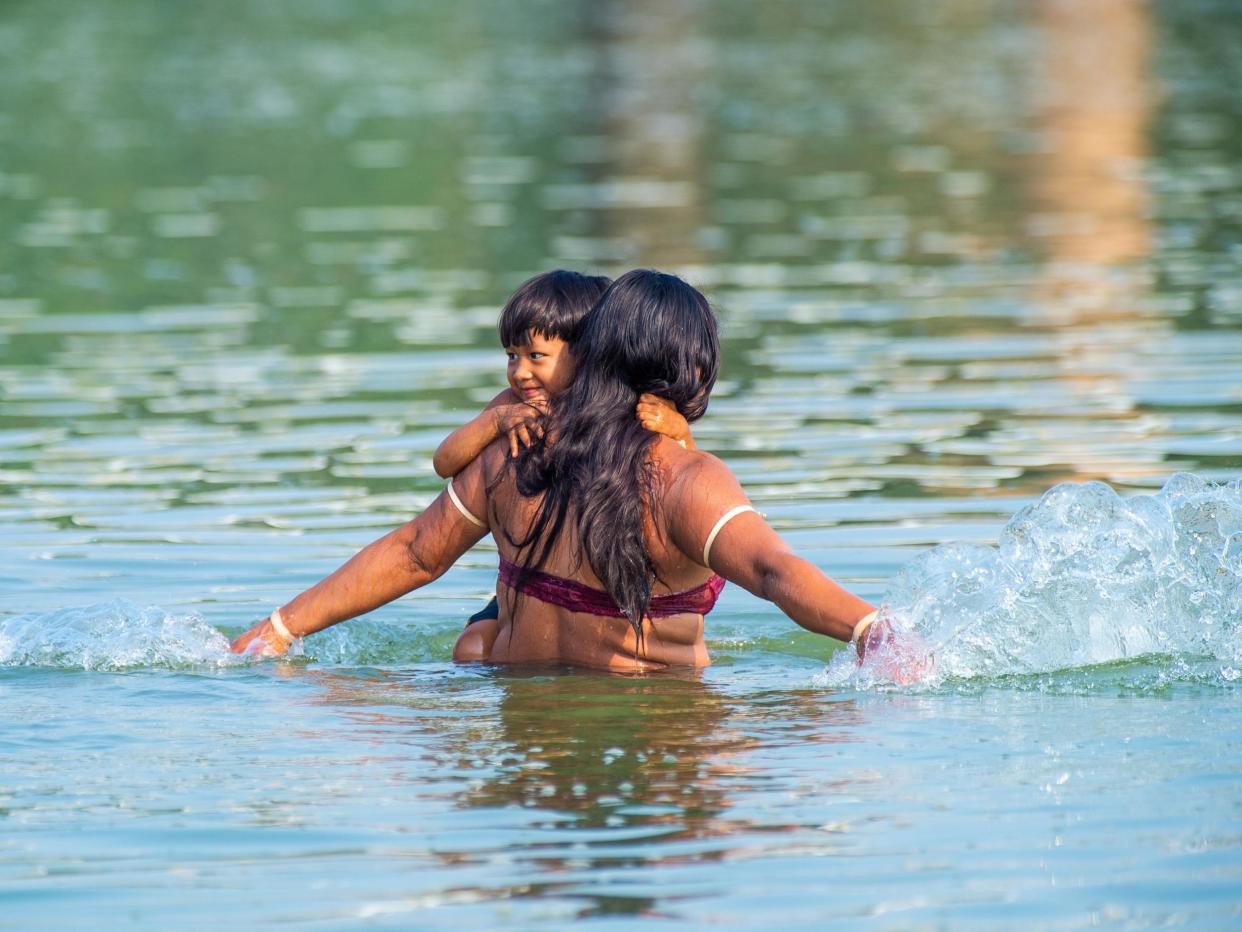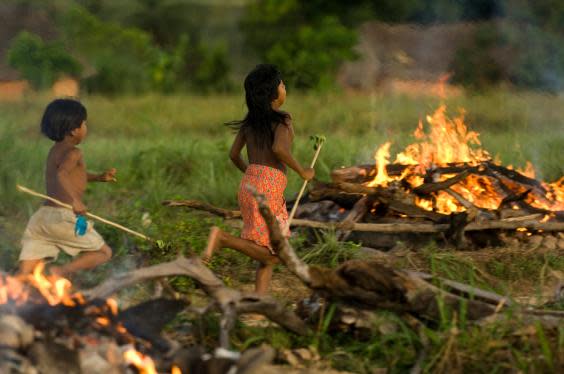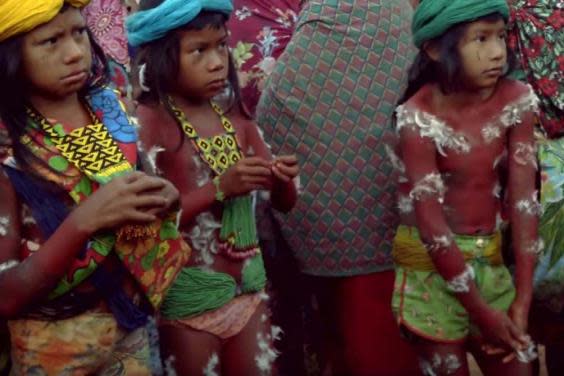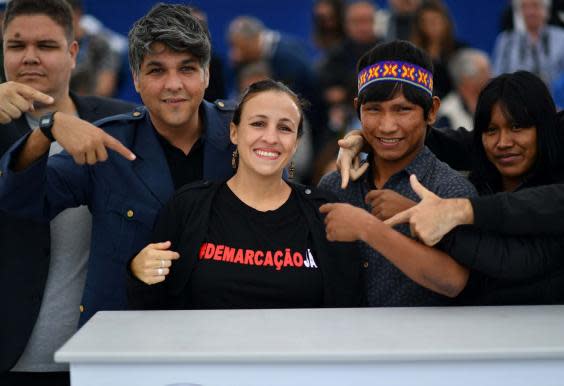For an indigenous group in Brazil, parenting literally takes a village

When filmmaker Renee Nader Messora and her husband João Salaviza moved from their home in Sao Paulo to an indigenous Kraho village in Brazil, the couple did not expect to become parents.
But Messora, 40, became pregnant with a girl while directing the movie The Dead and the Others.
When their daughter was born, one of the indigenous actors picked the baby up and began to breastfeed her. “Maybe that could have been weird and confusing to me if she wasn’t a Kraho, but she is a Kraho and I already knew how family dynamics work in the village,” Messora says.
Messora discovered what it takes to raise a child during her time at Pedra Branca, a Kraho village in north-central Brazil, she says. There, she says, the village is the key. And if that means another woman breastfeeds your baby? There’s a beautiful reason for that.
The Kraho people believe a child should have more than one mother. It’s so ingrained in the culture that the Kraho children use the word “inxe” for both their biological mother and their mother’s sisters or the women their mother considers as sisters, even if they’re not related by blood. In fact, there is no word for aunt. To the children, they are all mothers.
Read more
Millions of indigenous forest-dwellers face ‘world’s biggest eviction’
In indigenous cultures, women have a central role when raising children, even though indigenous motherhood is a broad concept, as one ethnic group can be very distinct from another. In Brazil, there are 305 ethnic groups that speak 274 languages, according to the Brazilian Institute of Geography and Statistics.
Messora first visited Pedra Branca in 2009. She has been here so often that the Kraho have given her and her husband their own Kraho names. She always stays at the house of what has become her Kraho family, although the concept of house is different from the one she is used to.

“It’s the complete opposite of what we learn in a western civilisation,” she says. “At the village there is an expansion of the core family, it’s not just about the mother, the father and the children. There are between 15 and 20 people in a house. Each house has more than one mother, the children are raised by everyone, the 4-year-olds take care of the 3-year-olds, who take care of the 2-year-olds,” she explains. “When a couple marries, the man moves into the woman’s house. All mothers stay together, there is a network of daughters, they breastfeed the children of their close relatives, my daughter Mira is breastfed by other women in our house.”
Each house has more than one mother, the children are raised by everyone, the 4-year-olds take care of the 3-year-olds, who take care of the 2-year-olds
Messora
Bruna Franchetto, a professor at the Department of Linguistics and the Department of Anthropology at the National Museum in Rio de Janeiro, says she believes her time studying and working in indigenous villages in Brazil might have influenced the way she raised her own son.
“I learned how to share my son with other women figures,” says Franchetto. “The big difference between raising a child in the city and raising a child in an indigenous village is that the children [in the village] go through this intensive process of socialisation, but at the same time they have a scary amount of freedom. In the city, we are surrounded by walls, cars, traffic. The child has a small social circle and has to overcome a lot of barriers to be able to enjoy an open space.”
Regardless of culture, there are different approaches to parenting. And there are as many ways to be a mother as there are mothers – French toddlers are expected to eat the same meals as their parents, Spanish kids stay up as late as they wish, Icelandic babies nap outside in subzero temperatures.
Indigenous children are raised to develop high autonomy from a young age, a valuable skill in adulthood. That allows them to be surprisingly agile and strong, and to be familiar with their surroundings.

“When I get back to the village, I feel a big difference,” Messora says. “Mira has a more autonomous life, she is not always holding onto her father and I.”
Ana Gabriela Morim Lima, a postdoctorate in anthropology at the University of Sao Paulo, points out that all children learn by playing and imitating their siblings and parents. The Kraho are no different.
“They believe that for someone to learn something, they need to ‘know how to see’ and ‘know how to listen’, ‘to open their ears and their eyes’. Only then you can learn the songs, how to move in the forest, how to identify the sounds of the birds and other animals, or how to follow their tracks,” says Lima. “To the Kraho and other indigenous people, learning depends on a corporeal and sensorial engagement with the world.”
To the Kraho and other indigenous people, learning depends on a corporeal and sensorial engagement with the world
Ana Gabriela Morim Lima, postdoctorate in anthropology
This close relationship to nature from an early age can make it hard for the Kraho to leave their village. Messora and her husband were at Cannes in 2018, where their film was awarded the jury special prize, with indigenous actors from the movie. In February this year, the movie was presented at Lincoln Center in New York, but the actors didn’t come. They don’t like to stay away from their village for long periods of time.
The actress who once breastfed their baby, Raene Kôtô Krahô, “thought everything in the big cities was very weird. She thought our apartment was always very empty, that people are away from each other and that there are a lot of people around but everyone is alone,” says Messora. “In the big city, we’re all alone in closed spaces.”
The indigenous actors were also disturbed to see homeless people sleeping in the streets.
“The Kraho share what they own with others, they believe things have to circulate. Detachment when it comes to things you own is a hard concept for us westerners to grasp, as we’ve been through centuries and centuries of private property,” says Franchetto.
Messora tells the story of a friend who lives in Pedra Branca who took his family to the city to see his parents outside of the village. There, his son received presents from his grandparents. As the family returned to the Kraho village, his son happily gave all his presents to his friends.
Kraho tradition dictates that childbirth should be at home, where women in the family take part in each others’ delivery. That creates a connection between the ancestors and the newborn, and the baby is welcomed by everyone the mother trusts. One of the most common positions to deliver a baby is to have the woman crouching on the legs of another woman who is holding her. Children are born as they fall right into their grandmother’s hands.

Even though indigenous mothers are advised to give birth at a hospital, some Kraho women still hold on to tradition. The nearest hospital is about 200 miles away from this village. If women choose to go, they pick someone to go with them who can help deliver the baby.
Messora and her husband want to go back to the village and raise their daughter there while they work on the production of an upcoming movie, also with the Kraho.
There are other mothers raising children in between cultures. Maira Pedroso, a 33-year-old mother of two from Sao Paulo, has been living with the Kraho for eight years. Once, her Kraho friend came to visit and brought along her 2-year-old daughter. The friend had come to do traditional body painting on Pedroso’s 6-month-old son. Everything was going well until the visitor’s little girl started screaming.
“That’s when my Kraho friend taught me a beautiful lesson. She calmly directed her daughter to paint just her arm and her daughter became quiet and allowed her mother to finish the work,” said Pedroso. “For us non-indigenous mothers, to offer a sense of freedom and a nonviolent education is a challenge that a lot of times requires us to go through a reeducation.”
Messora has observed the same trait.
“I have never seen a Kraho mother yell at a child. They do tell them they’re wrong, but they never yell. Education is a collective endeavour the whole village takes part on,” says Messora.
Education is a collective endeavour the whole village takes part in
Messora
There are also Kraho mothers living in the city who try to preserve their culture. Márcia Krahô, 21, has been living in Carolina, in the state of Maranhao in Brazil, for 10 years. Since she became a mother, she wants to spend more time in her village because of her son.
“I want my son to live between the village and the city, I want him to grow close to nature and to our family. In the city we feel a bit isolated,” says Márcia, whose son is 8 months old. “I want to teach my son what I was taught when I was a little girl. My friends and I used to have so much fun, we would bathe in the river, climb trees, run in the forest. We had a lot of freedom.”
For now, Messora and Salaviza are considering their options for where and how to raise their daughter.
“We think about our lives, we think about how we want to spend our time, where do we want to be,” Messora says. “I want my daughter to be happy and I’ve never seen anyone as happy as a Kraho child. In a city, I don’t see that this kind of freedom and this connection to nature can be possible. I want Mira to learn from them. I want her to know there are other things in the world apart from mobile phones and tablets. Many children are wasting their childhood with those devices and I don’t want that to happen to my daughter.”
© Washington Post
http://players.brightcove.net/624246174001/default_default/index.html?videoId=5837728067001
Support free-thinking journalism and attend Independent events
Read more
Read more Millions of indigenous forest-dwellers face ‘world’s biggest eviction’
Australia gets first ever indigenous cabinet minister in its history
Nike apologises for ‘pirating’ shoe design from indigenous group
Bolsonaro is destroying the lives of Brazil’s indigenous people
Indigenous women go missing at astonishing rates – but no one cares

 Yahoo News
Yahoo News 

